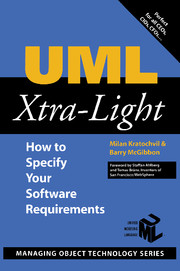Book contents
- Frontmatter
- Contents
- Foreword
- Preface
- Acknowledgments
- About the Authors
- How to Customize This Book
- Chapter 1 Introduction
- Chapter 2 Aligning to the Business
- Chapter 3 Adding Rigor to the Requirements
- Chapter 4 Sketching the Inside Structure
- Chapter 5 Sketching the Inside Dynamics
- Chapter 6 Moving Toward Components
- Chapter 7 Mapping from Classes to Data Models
- Chapter 8 Concluding Remarks
- Some Suggested Readings
- Index
Chapter 6 - Moving Toward Components
Published online by Cambridge University Press: 14 October 2009
- Frontmatter
- Contents
- Foreword
- Preface
- Acknowledgments
- About the Authors
- How to Customize This Book
- Chapter 1 Introduction
- Chapter 2 Aligning to the Business
- Chapter 3 Adding Rigor to the Requirements
- Chapter 4 Sketching the Inside Structure
- Chapter 5 Sketching the Inside Dynamics
- Chapter 6 Moving Toward Components
- Chapter 7 Mapping from Classes to Data Models
- Chapter 8 Concluding Remarks
- Some Suggested Readings
- Index
Summary
In recent years, an evolutionary change has occurred in the way modern systems are developed or, perhaps, we should now say “assembled”. Instead of building systems from the ground up – designing, constructing, and testing every part, thereby incurring time delays and huge costs – modern systems are being assembled from a combination of components to meet the needs of the business. These components or services might have been rented or bought from third-party suppliers, reused from previous systems, or built to provide a special set of services for the solution. The aim is to avoid building most of the solution.
This component-based development strategy can be summed up as “Reuse before you Buy before you Build”. It's the new approach to meet the needs of tomorrow. Interestingly, the UML, as well as 99 percent of this book, works fine with any of these alternatives, including a combination of alternatives. This chapter explains the background of many seemingly odd questions raised by IT people, which might seem to be too early in the project. As we show, components can early on play a key role in the bid/proposal stage of a project.
Yesterday's development approach was for large amounts of time and effort spent in developing basic parts of the system architecture, for example, visual controls, communications interfacing, and so forth with a smaller amount of time and effort spent in project-related activities, that is, delivering solutions, as shown in Figure 6-1.
- Type
- Chapter
- Information
- UML Xtra-LightHow to Specify Your Software Requirements, pp. 73 - 88Publisher: Cambridge University PressPrint publication year: 2002



